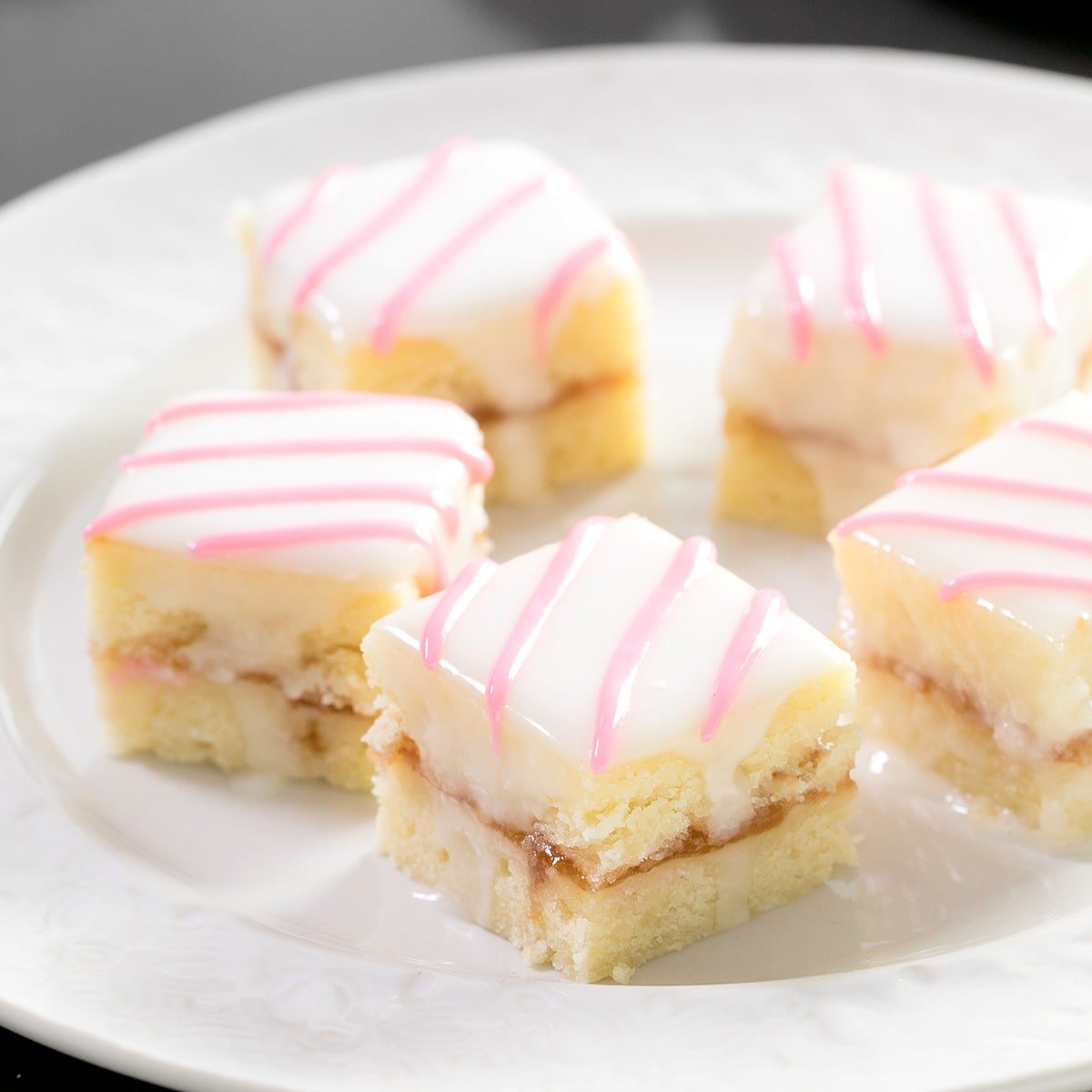

These delicate little petit fours are just tiny iced almond cakes, covered with a simple icing. If you've ever wondered how petit fours are made, or just what that icing is made of, this recipe is for you!

WANT TO SAVE THIS RECIPE?
What are petit fours?
The name “petit four” doesn't mean little cakes in French (which I had long assumed it did). Instead, it means “little oven,” which is apparently the way these delicate little cakes were originally baked. Honestly, that just makes them seem like they were made in an Easy Bake Oven. Moving on…
Petit fours can be made in a million different flavors, but the basic idea is to make thin rectangular cakes and layer them with some jam in between. Then, slice the layered cake into miniature squares, and ice them.
These gluten free petit fours are made with an almond cake that's very similar in taste and texture to the tricolor rainbow cookies you find in Italian bakeries. They've long been a favorite of mine, and I'm not above fighting you over the few rainbow cookies in the pastry box. I've done it before, shamelessly!
The cake itself isn't overly sweet but tastes like heavenly bites of marzipan. For an even more intense almond flavor, try adding 1/2 teaspoon of pure almond extract to the batter. The pourable icing is plenty sweet, which makes it the perfect offset to the rich cake. And speaking of icing…
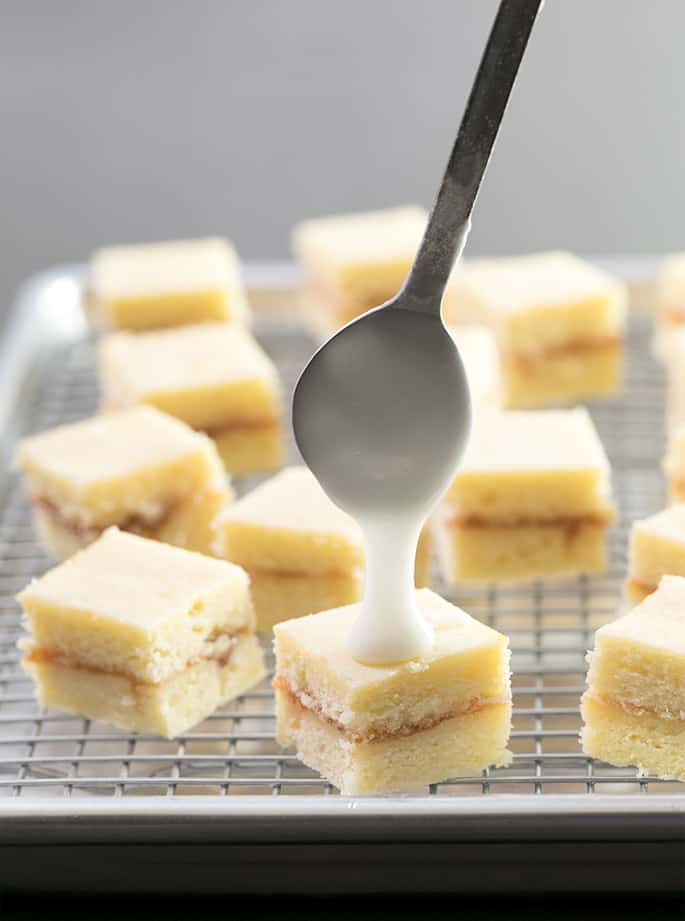
How to make the poured icing
The classic icing for petit fours is a pourable fondant, made from melted white chocolate, confectioners' sugar and light corn syrup. It's a thick and very sweet and decadent robe of icing around each delicate almond cake.
Since white chocolate varies significantly in quality from brand to brand, and the pourable fondant works best with the very best quality white chocolate, I decided to make things easier and go with a simpler, yet still beautiful, pourable icing.
The recipe for pourable icing below calls for meringue powder (LorAnn brand is gluten free; Wilton is not reliably GF), but you can leave it out. The icing simply won't be as hard when it sets. I've long been a fan of adding meringue powder to little confections and cookies, as I like to be able to stack and transport them easily.
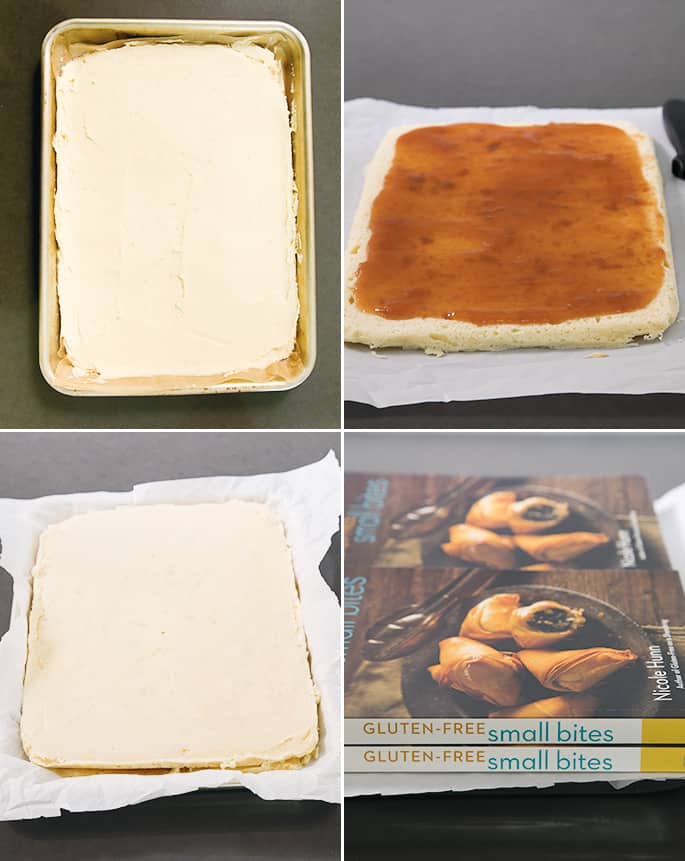
How to make gluten free petit fours
I much prefer making two rectangular, thin cakes and layering them rather than making one thicker cake and slicing it in half. It's not easy to slice a cake into multiple layers evenly, and the cake is quite tender and more fragile than a basic white cake.
The first cake, the one on which the jam is spread, should easily stay intact, without any cracking. After you layer the jam and layer the second cake on top, you may find that it cracks here and there. It's absolutely no problem, and it's simple to press the cakes into the jam and flip the whole thing over again.
When the bottom becomes the top, all is well. And remember—we're covering everything with that lovely pourable icing.
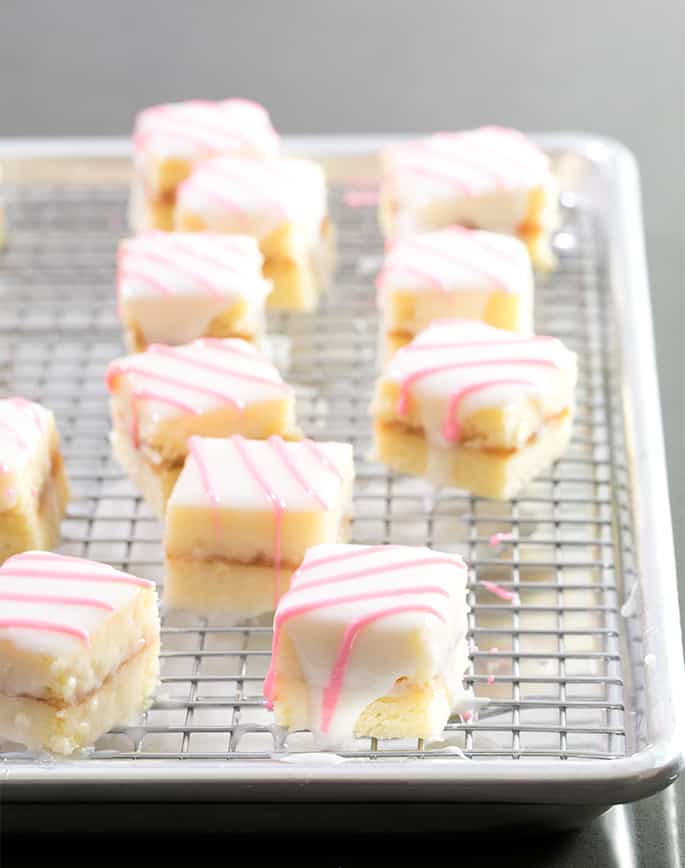
Gluten free petit fours ingredients and substitution suggestions
This particular recipe is full of dairy, eggs, and almonds, so substitutions are tough. I haven't tried this recipe with any of them, but as always feel free to experiment with these guidelines in mind:
Dairy free petit fours
With 1 full cup of butter in this recipe, it's a risk for sure to substitute it out. But my suggestion remains the usual: butter-flavored Spectrum nonhydrogenated vegetable shortening. I've also been using Nutiva brand shortening, which is a nonhydrogenated blend of palm and coconut oils, with good results.
Can you make egg free petit fours?
There are 4 whole eggs in this recipe. I don't think it can be made egg-free successfully. So sorry!
Nut-free petit fours?
There is no substitute for almond paste in this recipe. For an almond-free version, I'd recommend using my gluten free vanilla cake in place of this cake recipe entirely.
Easy Gluten Free Petit Fours Recipe
Ingredients
For the cakes
- 8 ounces gluten free almond paste broken up into small pieces (Solo brand is safely gluten free)
- 16 tablespoons (224 g) unsalted butter at room temperature
- ¾ cup (150 g) granulated sugar
- ¼ teaspoon kosher salt
- 4 (200 g (weighed out of shell)) eggs at room temperature, beaten
- 2 cups (280 g) all purpose gluten free flour blend (I used Better Batter; please click thru for full info on appropriate blends)
- 1 teaspoon xanthan gum (omit if your blend already contains it)
- ½ cup seedless jam heated slightly to make it spreadable
For the icing
- 1 ½ cups (173 g) confectioners’ sugar
- 1 teaspoon meringue powder
- 2 tablespoons milk plus more as necessary
Instructions
Make the cakes
- Preheat your oven to 350°F.
- Line 2 quarter sheet pans (each 12 inches by 9 inches) with unbleached parchment paper, and set them aside.
- In the bowl of a stand mixer fitted with the paddle attachment or a large bowl with a hand mixer, place the almond paste and butter and beat until well-combined and creamy.
- Add the sugar, salt and eggs, beating to combine well after each addition. The batter should be thick.
- Add the flour and xanthan gum, and mix until the dough is smooth.
- Divide into 2 equal parts and spread into an even layer in each prepared pan, using a wet spatula.
- The dough will be sticky.
- Place each pan, one at a time, in the center of the preheated oven and bake for 12 minutes, or until the cake just begins to brown around the edges.
- Remove the pan from the oven and allow to cool slightly.
- Invert one cake onto a large piece of parchment paper on top of a cutting board, and evenly spread the jam on it.
- Invert the second layer carefully on top, taking care not to handle the cakes too much or they’ll begin to crack.
- If the cake cracks, just press it together as the jam will hold it firmly in place.
- Place a sheet of parchment paper on top. If the top cake has cracked at all, invert the entire stack so that the cracked cake is on the bottom.
- Place a heavy book or other flat object on top of both cakes to compress the layers.
- Place the stack of cakes, along with the book perched on top, in the refrigerator for about 30 minutes, or until the layers are compressed.
- Remove from the refrigerator, remove the top sheet of paper, and cut the compressed cake into 1 1/2-inch squares with a sharp knife or square cookie cutter.
- Place the square cakes on a wire rack over a parchment-lined sheet pan, and set aside.
Make the icing
- Place the confectioners’ sugar and meringue powder in a medium-sized bowl and whisk to combine.
- Add 2 tablespoons of the milk and mix to combine.
- It should form a thick paste. Add more milk by the quarter-teaspoonful, mixing vigorously until it reaches a very thickly pourable consistency.
- Spoon the icing over the individual cakes.
- For extra fancy petit fours, add a drop or two of gel food coloring to some of the icing, and drizzle over the top of the white icing. Allow to set at room temperature
WANT TO SAVE THIS RECIPE?

Thanks for stopping by!
Hi, I’m Nicole. I create gluten free recipes that really work and taste as good as you remember. No more making separate meals when someone is GF, or buying packaged foods that aren’t good enough to justify the price. At Gluten Free on a Shoestring, “good, for gluten free” just isn’t good enough! Come visit my bio!
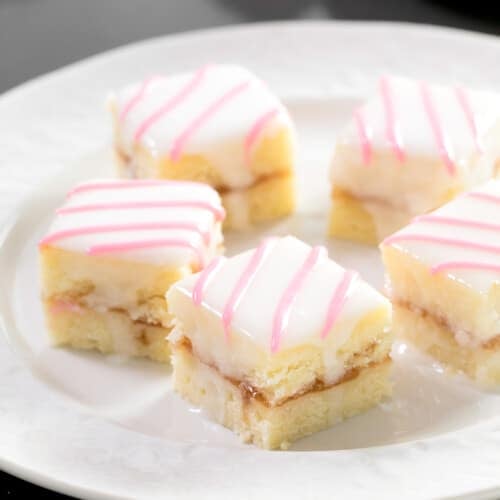
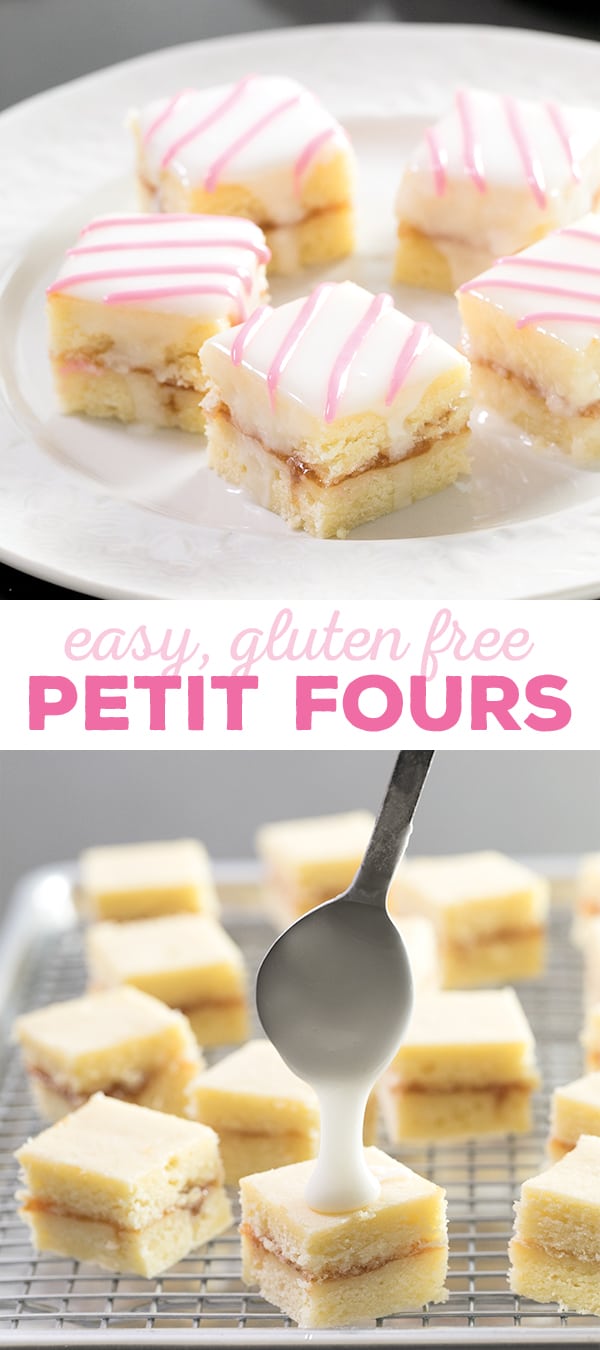

Jean Ann says
These were such a hit at our Christmas Eve dinner! Thank you so much for this adaptation of the icing as I am unable to eat the white chocolate original fondant. I was so happy to have a GF treat and no one else even knew the difference! Nicole you are a gift to us all!
Nicole Hunn says
That’s awesome, Jean Ann!! Isn’t that lovely, when everyone eats the same thing and everyone enjoys. I find that it brings you together in a way that separate, segregated dishes simply can’t do.
AMANDA GEISEMAN says
How do I substitute for the meringue powder…ive looked everywhere! Do you have any suggestions?
Sincerely,
I can’t screw this Christmas dessert up in Indiana.
Nicole Hunn says
As I discuss in the post, Amanda, you can simply omit the meringue powder if you can’t find it (although it’s readily available online, and in many kitchen supply stores). The icing just won’t set up as well.
heather says
Just made these today. AMAZING! I baked in large sheet pan as one cake and cut in half. Used grape jelly, as that was all I had. They taste so good!
Thank you Nicole for always creating fool-proof recipes.
Eileen says
I have all your cookbooks. What cake recipe would be closest to an Italian Cream Cake?
Nicole Hunn says
I’m afraid an Italian cream cake is a relatively unique cake, since you generally separate the eggs and fold the whipped egg whites into the batter, and add a bunch of mix-ins. None of my cakes is exactly like that. Sorry!
Dal says
I’m also diabetic so what do you have in low or no sugar baking goodies
Nicole Hunn says
I’m afraid I don’t provide sugar-free recipes, Dal. Sorry!
Lisa Huff says
Sounds delicious!
marilyn warren says
Hi firstly is almond paste marzipan we are in the UK so have different names for things. Secondly meringue powder we don’t have that either can i substitute egg white? thanks
Nicole Hunn says
Hi, Marilyn,
I just researched this, and apparently in the U.K. almond paste and marzipan are the same thing! In the U.S., they’re different (in the U.S., marzipan has more sugar than almonds, but not so in the U.K.). As I explain in the recipe, you can just leave the meringue powder out and your icing just won’t be as firm when set. Egg white powder won’t have the same effect, no.
Linda says
These are so pretty!! I want some now!
Nicole Hunn says
Thank you, Linda!